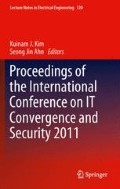Abstract
In Smartphone a touch screen has changed the paradigm of user interface on personal computing devices just through single software rather than hardware keyboards and number pads. Therefore it is receiving most of the attention as mobile UX (User eXperience). This paper explores the process of touch event and the feasibility of increasing the performance of it on Android Froyo and Gingerbread. For this purpose, this paper suggests a technique to improve the performance of touch event screen update by using virtual touch event without being synchronized to touch event. The simulation results show that the proposed method can increase 15% of performance on processing the number of frames as for frame per second.
Access this chapter
Tax calculation will be finalised at checkout
Purchases are for personal use only
References
Google. Designing for Performance (2010) URL http://developer.android.com/guide/practices/design/performance.html
FitzRoy-Dale N, Kuz I, Heiser G (2010) Architecture optimisation with currawong. In: Proceedings of the first ACM Asia-Pacific workshop on workshop on systems, pp 7–12
Official Android website. http://www.android.com
Enck W, Octeau D, McDaniel P, Chaudhuri S (2011) A study of android application security. In: Proceedings of the 20th USENIX security symposium, August 2011
Open Handset Alliance, Android overview. http://www.openhandsetalliance.com/android_overview.html
Dalvik Virtual Machine. http://www.dalvikvm.com
Steele J, To N (2010) The android developer’s cookbook building applications with the android SDK. Addison-Wesley, Reading
Acknowledgments
This research was supported by Basic Science Research Program through the National Research Foundation of Korea (NRF) funded by the Ministry of Education, Science and Technology (KRF 2011-0027264).
Author information
Authors and Affiliations
Corresponding author
Editor information
Editors and Affiliations
Rights and permissions
Copyright information
© 2012 Springer Science+Business Media B.V.
About this paper
Cite this paper
Lim, YG., Kim, C.G., Kim, S.D. (2012). A Study on the Touch Process of Android Smartphone on Froyo and Gingerbread. In: Kim, K., Ahn, S. (eds) Proceedings of the International Conference on IT Convergence and Security 2011. Lecture Notes in Electrical Engineering, vol 120. Springer, Dordrecht. https://doi.org/10.1007/978-94-007-2911-7_17
Download citation
DOI: https://doi.org/10.1007/978-94-007-2911-7_17
Published:
Publisher Name: Springer, Dordrecht
Print ISBN: 978-94-007-2910-0
Online ISBN: 978-94-007-2911-7
eBook Packages: EngineeringEngineering (R0)

